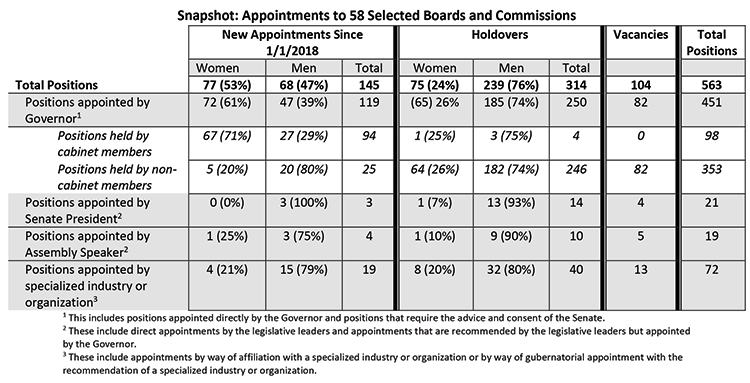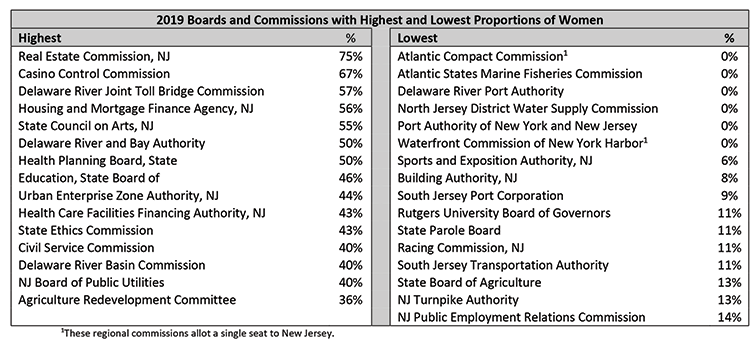Contact: Daniel De Simone; 760.703.0948
Since Phil Murphy assumed the governorship in 2018 there has been a modest improvement in women’s representation on select New Jersey boards and commissions, according to an analysis from the Center for American Women and Politics, a unit of the Eagleton Institute of Politics at Rutgers University. Prior to Governor Murphy’s inauguration in January 2018, women held 18% of positions on select state boards and commissions; as of July 2019, that figure has increased to 27%. While a welcome change, much of this improvement derives from Governor Murphy's cabinet selection, due to cabinet members’ inclusion on state boards and commissions, but the administration has not, thus far, appointed women to public member positions on these state boards and commissions at or near parity levels.
Of the nearly 500 New Jersey state boards and commissions, CAWP analyzed the membership of 58 of those that are widely considered to be among the most powerful, with high levels of responsibility and requiring financial disclosure. Of the 563 positions on those select boards and commissions, 152 are currently held by women, 307 are held by men, and 104 remain vacant. When Governor Murphy assumed office, 103 of these positions were held by women, 371 by men, and 89 were vacant.
Much of this increase in women’s representation is attributable to Governor Murphy’s appointment of a woman-majority cabinet, a first in New Jersey history, as many state boards and commissions have seats reserved for cabinet members. Of the 119 new appointments made by the governor, 72 (61%) are held by women, while 47 (39%) are held by men. Of those 72 positions, however, 67 are held by women in the governor’s cabinet. Of the 25 positions on select boards and commissions held by non-cabinet members so far appointed by Governor Murphy, only 5 (20%) are women, while 20 (80%) are men. The cabinet appointments mask the reality that few women have been appointed to the public member positions on these powerful boards and commissions. Governor Murphy has the opportunity to improve this weak spot on his record of women’s appointments with the remaining 82 vacant positions on boards and commissions under his discretion.

“Murphy’s appointment of a majority-women cabinet is important in and of itself,” said CAWP Director Debbie Walsh, “but the impact of that leadership cascades, as these cabinet members assume roles on boards and commissions. For instance, because of the governor’s appointment of Elizabeth Maher Muoio as the State Treasurer and Diane Gutierrez-Scaccetti as Commissioner of the Department of Transportation, there is a woman serving on the New Jersey Lottery Commission and on the Turnpike Authority, respectively, for the first time in years. However, among the public member seats on these boards and commissions, there is room for significant improvement. With 82 vacancies, the potential is there.
” While the vast majority of positions on the 58 boards and commissions analyzed for this study are appointed by the governor, 40 positions are appointed, directly or indirectly, by the state senate president and assembly speaker. Of those, 24 positions are holdover appointments predating the Murphy administration. Since January 2018, Senate President Steve Sweeney has appointed three people to select state boards and commissions; none of these appointees have been women. Assembly Speaker Craig Coughlin has appointed 1 woman among the 4 appointments he has made so far. As with Governor Murphy, Senate President Sweeney and Speaker Coughlin have opportunities to improve: Senate President Sweeney has 4 available appointments that remain vacant on these select boards and commissions, while Speaker Coughlin has 5.
CAWP also provides a ranking of the select boards and commissions with the highest, and lowest, levels of women’s representation. The Real Estate Commission of New Jersey has the highest proportion of women currently serving, with women holding 75% of positions. On a further 6 select boards and commissions, women hold 50% or more of seats. On 16 boards and commissions, women make up less than 15% of members; 14 have only one woman serving. On 6 boards and commissions, there are no women serving at all (of these, 2 are regional commissions drawing members from multiple states that allot only a single seat to New Jersey).

Contact: Daniel De Simone; 760.703.0948

